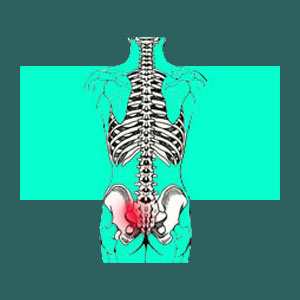
The thigh thrust test is one of several pain provocation evaluations that can be used when trying to confirm or deny a diagnosis of SIJ pain. The test is simple to perform and is best utilized in combination with other tests of similar objective.
The thigh thrust evaluation creates discomfort in the vast majority of people who are affected by sacroiliac joint pain. This makes its sensitivity quite good, although specificity for SIJ pain is not as accurate, since many patients with other types of pain in the hip and lower back might also complain of discomfort during the test.
This short and simple essay details the thigh thrust test for sacroiliac joint pain diagnosis. We will discus the pros and cons of the test and include recommendations for caregivers and patients alike regarding the accuracy of the test.
Thigh Thrust Sacroiliac Test Procedure
This test is best administered with the patient lying supine on an examination table. The care provider should stand on the side of the patient on their asymptomatic side for best results.
The examiner will elevate and bend the patient’s symptomatic leg to an angle of 90 degrees at the knee. They will also slightly abduct the leg. The examiner will then reach under the patient and place their hand palm up on the sacrum of the patient. The examiner will then re-center the patient and use their arms and body to apply pressure in short thrusts of increasing intensity longitudinally through the leg and into the SIJ, which will reproduce familiar pain in most patients with a variety of SIJ disorders.
Some care providers will repeat the test on the asymptomatic side just for a reference and to see if pain is produced there which might disqualify the SIJ as the culprit.
Thigh Thrust SIJ Test Pros and Cons
On the good side, the thigh trust diagnostic test is simple, fast and easy to perform. It can be used by chiropractors, physical therapists, PTAs, physicians, massage therapists and various other types of complementary caregivers. The test will produce pain in most people who have sacroiliac joint issues, making it valuable as part of an evidence gathering evaluation process.
Specificity of the test is not great, similar to most of the other sacroiliac joint pain provocation tests. People with hip or lower back disorders often complain of pain from all of these techniques, as well, increasing the likelihood of misdiagnosis, which is already a huge problem in the chronic pain sector.
Additionally, the test can be very painful for some patients, so care providers should take extra care to work into the test gradually and not simply apply significant force into the leg from the first thrust for humanitarian purposes.
Thigh Thrust Sacroiliac Test Facts
Thigh thrust evaluation is best utilized along with other pain provocation techniques, such as the Faber Test, Gaenslen Test, iliac gapping test and iliac compression test. None of these tests are conclusive unto themselves, but are valuable when used in combination with one another for best diagnostic accuracy.
Patients who have pain upon being subjected to thigh thrust examination should be certain to rule out other common causes of suffering before accepting a diagnosis of SIJ disorder. Many lumbar, sacral and hip pain syndromes will be exacerbated by this exam, as will some soft tissue conditions, as well. Therefore, caution is suggested to be sure that thigh thrust examination is just part of a comprehensive diagnostic process carried out by a qualified and objective care provider.
Sacroiliac Joint Pain > Sacroiliac Diagnosis > Thigh Thrust Sacroiliac Test





